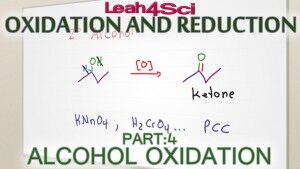 Alcohols can be oxidized to aldehydes, ketones and carboxylic acids.
Alcohols can be oxidized to aldehydes, ketones and carboxylic acids.
The specific product will be determined by the substitution of the starting alcohol, and the specific oxidizing reagent used in the reaction.
This video will show you how to identify the oxidation products (or lack of) for primary, secondary and tertiary alcohols.
We'll look at the most common oxidizing reagents including the chromium family such as H2CrO4 and Na2Cr2O7, Potassium Permangate KMnO4, and Pyridinium Chlorochromate PCC
(Watch on YouTube: Alcohol Oxidation. Click cc on the bottom right for video transcript)
Reference In this video: Pencil Trick for Classifying primary/secondary/tertiary carbons and alcohols
<–Watch Previous Video: Birch Reduction Reaction and Mechanism
–>Watch Next Video: Alcohol Oxidation Mechanism H2CrO4 PCC KMnO4
This is video 4 in the Orgo Oxidation/Reduction Series. Click for complete series
Ready to test your redox skills? Try the Redox Practice Quiz and follow along with the Redox Cheat Sheet


